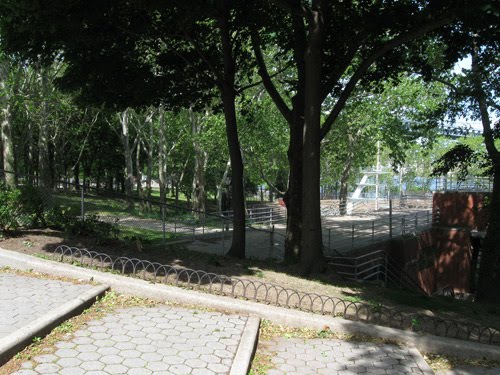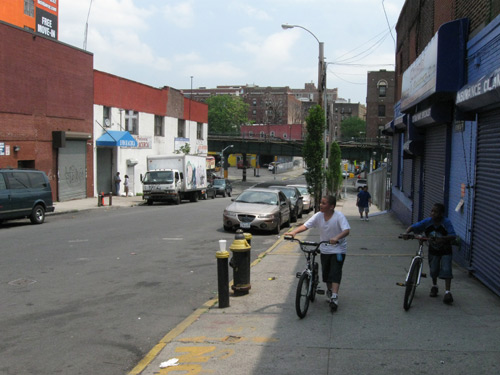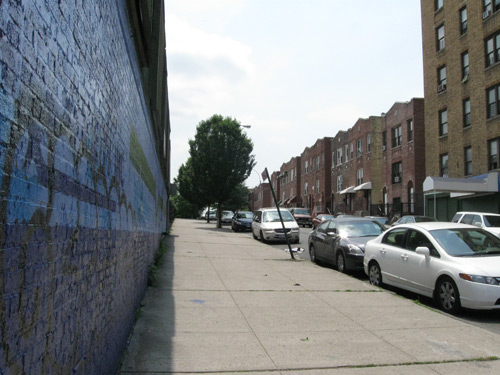I realize I haven’t been blogging very much lately. The truth is that the actual work of putting the film together swallowed me up for a bit, which left precious little time left over for reflecting and writing on what I was doing.
June was a very busy month. A few of the things on the to-do list:
- Two Location Scouts
- Filing the Tax Incentive applications with the City and State of NY
- Filing the Screen Actors’ Guild paperwork
- Doing a new breakdown and schedule for the film
- Calling locations and soundstages
- Bidding on insurance
- Prop shopping
- Hiring the casting director and preparing for casting
- Further script analysis
- Setting up company credit cards, and the Quickbooks/filing system for the film
I’ve also been trying to study other low-budget fantasy films such as the recent Ink, The Science of Sleep, Cold Souls and Gabbeh (if you haven’t seen these, I recommend them all highly). Gabbeh, in particular, fascinates me. Without any kind of special effects, it manages to utterly convince you of the authenticity of the magical world it creates.
Anyway, one of the overriding lessons of June is the importance of being organized. There are many preproduction checklists out there. But most assume a very idealized schedule and that you’ll have a team of people working for you. Here I’m trying to condense it into a list that’s manageable and more realistic for the folks who are producing films literally on their own or with one or two other people. As such it’s organized more or less in priority order (of course, film preproduction is nonlinear and fluid).
CORPORATE STUFF:
Anything that involves should be taken care of as soon as you have a date set. This includes creating your production company, putting the legal paperwork together for your investors and partners, setting up your bank account and credit cards, getting a resale certificate, etc. This is time-consuming stuff and involves government entities, which move on a slow timetable. So don’t put it off.
SCRIPT ANALYSIS:
You can never do too much of this. As a crew member, I used to hate it when the director seemed like the least prepared person on set. There’s a difference between being “fresh” (not getting sick of the material before walking on set) and being unprepared. Properly analyzing your script will never make you sick of the material, only lead you to a deeper understanding of the story you’re trying to tell. It will also give you the materials you’ll need to help you communicate with the cast and crew.
In my mind, script analysis includes the following:
- Preparing a character breakdown for the casting director
- Taking general notes
- Looking at the script from the characters’/actors’ POV (see Judith Weston’s books on this)
- Storyboarding
- Shotlisting
- Preparing a “vision statement” that uses other films, stills, artworks, music… anything that someone can grab and watch/listen to/read to get a sense of what you want to accomplish
- Figuring out what sides you want to use for auditions
- Rewriting the script based on the above
This should be happening throughout the preproduction process. It becomes harder to do as preproduction goes on, since it demands stretches of uninterrupted time. So start this as soon as you have a draft that you think could be shot. I also recommend “saving” everyone (including yourself) huge headaches by refraining from publishing new drafts until you’ve “ganged up” a few significant changes. Publishing new pages every couple of days is not going to endear you to anyone. On a really low budget film, you are GUARANTEED to get out of sync (with actors, crew, director and producer all showing up on set with different drafts).
PRODUCTION ANALYSIS:
This broad category includes breaking down the script, scheduling it, and budgeting it. This should start as soon as you have a workable draft and will (for better or worse) be an ongoing process. You should try to generate a budget, a location breakdown, and a cast list as soon as possible. I’ve written about this before, so I won’t go into too many details here.
LOCATIONS:
Try to nail your locations, or at least start exploring possibilities, as soon as possible. I’ve written extensively on location scouting considerations, so I won’t go into it here. I want to add two things: be prepared to bribe people to turn off their radios, park somewhere else, etc. And have a backup plan. You don’t want to lose a day of shooting if a location gets scotched.
Use the best aspects of a location – even if it means bending the story a little bit. I once worked on a film where we had to find a country house for a corporate law firm partner. We found a beautiful, “rich-looking” house with two giant floor-to-ceiling, two story windows. But the scene was set at night, and we were shooting during the day. The DP and director wouldn’t budge, so we gelled the windows (which took forever), and shot away from them – blocking everything in front of an interesting but rather “non-opulent” wall. The issue of wealth (important to the characters and the film as a whole) was lost.
CASTING:
You should start thinking about this as soon as the script is done. Do you know a “name” actor (and I mean know in the sense of actually having met, talked, worked with, and NOT in the sense of having lots of posters of him/her in your room or that you’ve stalked them or followed them on “E”)? Do you know good “non-name” actors? Do you know a casting director?
The casting process is in many ways the hinge that the rest of the film swings on. If you cast well then many of your headaches will disappear on set (to be replaced by others, of course). Cast badly and you’ll be wasting a lot of money and time. Note that casting well doesn’t necessarily mean casting a name, or even someone with a lot of experience. But:
- Do they bring the role to life?
- Do they think of things you haven’t thought of?
- Are they committed to the sometimes arduous nature of the process (they refuse to coast on indication and cliche)
- Do they have chemistry with each other?
- Will they show up on time?
- Do they understand the hours and time commitment, or will you have to compete with their day jobs or significant others?
These last two sound funny, but they’re not. I’ve worked (as a production manager) with musicians cast as actors. They tend to be very good, but many don’t understand the concept of a seven-AM call time.
I’ve also worked with actors who told me on the day that they had to get to their catering jobs two hours before we were scheduled to wrap. My sympathy is limited – I’ve passed up day job money, sleep, sex, a few friendships, and a vacation or two to stay in this business. If you can’t walk the walk, don’t talk the talk.
On the other hand, if you’re working with an actor who’s got another ACTING commitment, then you have to respect that commitment and work around it. If you can’t, don’t cast that person, or wait until their commitment is over before you shoot.
Also, if your dates aren’t solid (they won’t slip by more than a few days), you can’t expect any actor, no matter their level of experience, to wait around for you.
CREWING UP:
Crewing up is both difficult and easy at the same time. It isn’t hard to find people who want to crew on films. The problem is finding people who are willing (see above) to stick with it during some tough times, and/or are also willing to take a pay cut to work on an indie film. Also, since everyone is a freelancer, you can’t ask someone in May what they’re schedule is going to be like in December. Unless the paycheck you’re offering is awesome AND your dates are solid, you’re going to have to settle for a “if nothing else comes up” commitment.
So start looking at reels and interviewing people, by all means, but don’t count on hiring people for sure until a couple of months before the shoot starts.
PROPS, SET DRESSING, COSTUMES:
I like to create shopping lists of the props, set dressing, costumes, wigs, etc. that I’ll need to obtain for the shoot. In creating this list, I focus on the following:
- What’s already at the location that I can use for free/cheap?
- What do I own?
- What can I borrow for free?
- What can I rent for cheap?
- What can I “buy and return?”
- What do I have to fabricate or purchase?
This leads to a lot of dumpster-diving, making phone calls to friends, closet-raiding, and other activities. The good news is that you don’t have to do all this work at once. The bad news is that, like everything else on this list, you should start it as early as possible.
One thing I would caution against is assuming that actors can bring their own wardrobe. Depending on their financial situation, day jobs, and/or taste, you may not be able to find a three-piece suit or formal evening gown in their closets that you can use. And if you do, keep in mind that it’s your responsibility to make sure they show up with it on the day, that it’s cleaned regularly, and that a second rented/purchased, if possible. Actors sweat a LOT – the lights are hot, the AC has to be off for sound, and the work itself is nerve-wracking and physical – so make sure they can get into a clean version of their clothes the next day.
Similarly, locations are seldom perfect and may change between the scout and the shoot. You may have to live with the location as is (not always the worst thing in the world), or spend some time before the shoot crew arrives rearranging things. The key on a low budget is to be flexible.
There’s more to come, but I’ve got to get back to work here. Casting begins in a couple of weeks. I’ll let you know how that goes!







